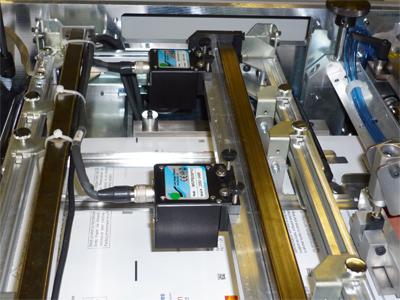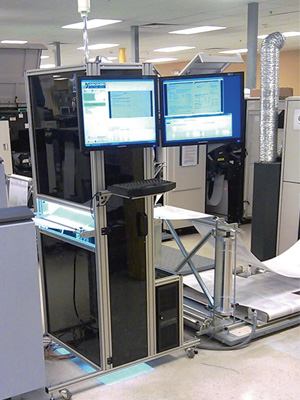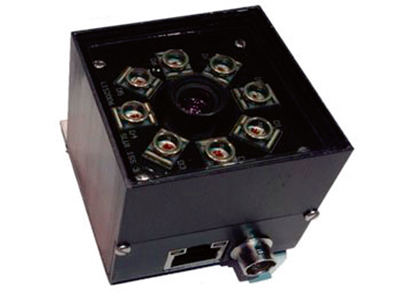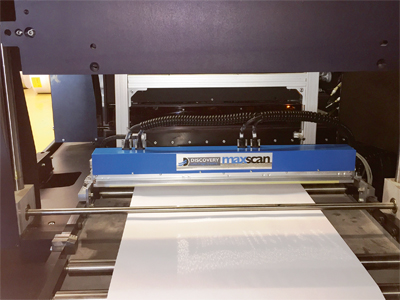One of the all-in-one GR Matrix image cameras reading QR codes on a Pitney Bowes 72K cutting station
Simon Eccles visits Lake Image Systems, the UK’s market leader in machine vision systems, which is seeing ever-more applications in the verification and control of print.
Machine vision for printing systems has a surprisingly long history. The first camera-based image analysers appeared in the 1980s, before digital presses or even true digital cameras. Today’s vision systems play an increasingly important role in organising and verifying variable data work in digital printing. By reading codes or even words on digitally printed sheets, they can trigger the appropriate feed bins to assemble sets of documents for binders or envelope inserters, or even feed back to a database to command the printing of matching addresses and other material on envelopes, polywraps, book and brochure covers and the like. They can also be used in quality control, for checking on colour, positioning, registration and content in general.
As anyone who visits a supermarket knows, a scanning laser beam will read a striped barcode. However, such codes are fairly large and can only carry a very limited amount of information. 2D (or matrix) barcodes can carry a lot more information in a considerably smaller block than your baked bean tin’s 11-digit UPC stripes, but they need a machine vision system to read them. Modern cameras and reading software are getting very good at detecting small and even blurred 2D codes. If you have a phone made in the past two or three years, its camera and code-reading app will be vastly more reliable than those of five or six years ago. Digital Printer ran a comparatively early trial of QR codes on the cover of the May 2010 issue, that linked to a live news website for that month’s Ipex show. It worked, but the QR code had to be a couple of cm square before it could be reliably read by the phones of the time. Today you can get away with well under 1 cm with a surprising amount of blur, and the code can still be read through a polywrap.

One of the all-in-one GR matrix image cameras reading QR codes on a Pitney Bowes 72K cutting station.
For the past 21 years, the UK’s Lake Imaging Systems in Tring has been a pioneer and leading light in machine vision systems for the printing sector. These are a combination of cameras/sensors with data delivery to third party mailing systems. It used to buy cameras in, but since 2003 it has built its own. Today’s fourth generation matrix cameras are built as complete pre-focused units, with integrated LED lamps and fast Ethernet connectors. It has also developed the MaxScan range of 600 dpi strip sensors, rather like very fast colour scanners, that can cover the whole width of a printing or finishing line with a choice of 30, 60 or 90 cm widths.
‘A lot of our equipment is integrated into new-build equipment,’ said Nick Khatri, group marketing manager. ‘Our customers include Pitney Bowes, CMC UK, CMC Italy, Buhrs/WMD, Kern, as well as aftermarket fitting to refurbishers such as ProMail. Pitney Bowes is one of our largest customers, but we also supply unlabelled systems to some OEMs which sell them as their own. We’ll also sell directly to end users who are updating existing kit. Often this is because they have a new contract that needs some sort of data integrity.’
Evolving requirements
Lake Imaging got its big break with the adoption of loyalty cards by Safeway some 20 years ago, says managing director Martin Keats. ‘Olwen Direct Mail, the forerunner of REAL Digital, got a job to mount the cards onto mailshots and needed to verify the line that glued the cards to the documents. Tesco, Boots and WH Smith were among those that followed and the market boomed. We started to concentrate on this side of the market.
‘A lot of our first customers were also doing direct mail work on old Bell & Howell inserters. They started to ask us for systems that worked on these too. Previously complex multi-part mailshots were done by hand. We were able to work with small codes, not the big barcodes. It meant that mail houses could insert multi-part mail pieces at 6000 per hour, rather than using teams of humans for visual checking. This spread into lottery cards, direct mail, transactional, hybrid mail, labels and phone cards.
‘So 20 years ago we were letting our customers put together mail pieces that were far more sophisticated than anywhere else. The UK is a small market compared to the USA, but it still has higher quality and more innovation.’

This is a Discovery control station with keyboard and twin status monitors.
Today’s mail is getting ever-more complex, so the requirements for visual detection and checking are expanding too, said Mr Keats: ‘What you do with the data is more important than ever – not just matching and verification, but looking for duplicates or missing copies, then producing reports that specify what went out of the door. The camera system may drive the mail sorting directly. Some companies archive an image of every piece. As white paper mailing becomes more common we’re moving more into colour quality checking. With black-only overprinting onto flexo or litho shells you only need to check the black integrity.’
Cameras or scanners are the starting point for any machine vision system. ‘We used to use cameras with separate lenses,’ Mr Keats said. ‘Now we build our own cameras which are complete units.’
The company’s third and fourth generation 2D matrix cameras are compact blocks with a glass face, behind which are the lens and a ring of LEDs. There is no need to worry about focusing the lens, as the camera is just positioned at a set distance above the print and it will work with no further adjustment needed. The fourth generation cameras have built-in GigE (Gigabit Ethernet) connectors, which allow much faster data rates then previous cables. ‘We haven’t used analogue video for a couple of years,’ Mr Keats said. ‘GigE lets us move data at high speed and process it, then make decisions in milliseconds.’

This video camera (with the round lens and blue cable), uses a new technology liquid lens that allows it to refocus very rapidly on labels at different distances. It can switch from 50 to 300 mm focus nearly instantly. It’s mounted on a CMC package wrapper for a mail order supplierr where every pack may be a different size.
Complete systems
Lake Imaging’s Discovery Multiscan3 is its current package of camera systems, with quality inspection for variable print applications. Operating on machines running at up to 350 metres per minute, it adopts the latest generation of area and line scan cameras, including the MaxScan full width scanner, to capture high quality, high resolution images. These are processed to detect, extract and decode all forms of barcodes, QR and OCR codes for subsequent processing by Multiscan3’s integrity, inspection, control, and reporting applications.
A system like this can cost from £10,000 to £25,000, starting with one camera and progressively adding cameras and intelligence. These capabilities are expanded with Discovery Read & Print. This adds a drop-on demand inkjet for coding and marking, controlled from a PC. The thermal inkjet has a 600 x 600 dpi resolution, in black and spot colours. There are also versions for labels, packaging and Enterprise.
The new Discovery Web2print concentrates on the finishing side, so for instance a fast turnaround personalised greetings card service can use an area scan camera to read codes on cards as they go through the inserter, which generates the printing of the appropriate address on the envelope, with verification that each card was then mailed to the recipient.
Also new is Discovery RFID, whichh can read printed codes and use the results to generate encoding of embedded RFIDs for high end vouchers, loyalty cards and the like.
Expanding capabilities
The demand and applications for camera systems have expanded a lot since the early days, said Mr Keats: ‘When we started, customers just wanted to match the addresses on envelopes to insert names and addresses. Now they need to demonstrate and prove that if they say they’ve delivered to 100,000 named people, then they actually did so. The labelling and data and reporting is now vital. If something goes missing we can generate a report and also trigger a reprint if needed.

This cube is Lake’s latest fourth generation GR matrix camera, with all components fixed in place for very easy mounting. The central lens is surrounded by LEDs, with the GigE port at bottom left.
‘As integrity requirements increase we can handle multiple jobs distributed across several machines, perhaps produced over a number of days. We can track what has gone and what has not and look for duplicates. We can verify good pieces on the press and track them all the way to the inserter. This will work with both white paper and pre-printed operations.
‘Reading the codes may trigger additional actions, such as tipped-in cards, or particular insertions for the individual. Apart from codes, we can look at print quality, such as positioning, registration and printers’ marks, that the correct logos and colours are used as well as the correct paper, in mixed or co-mingled mailings. We can check that the front and back information matches, as it’s not unknown for these to get out of sync. One digital printer used to have problems where the black would match but other colours sometimes didn’t.
‘We can also check the readability of codes needed in the mail system. We could check colour quality too, including delta E variation for each colour, though we’ve never been asked for it for mailing.’

The latest in machine vision, a full-width, full-colour MaxScan head that can read codes or text at any point
The work involved to integrate a camera system depends on the level or native intelligence, said Mr Keats. ‘If we go into a brand new machine today, say a Pitney Bowes, then very often it has the intelligence built in, so we just need to feed the data. If we’re upgrading a 20 year old machine, we can add value by installing the intelligence too. This gives a whole new capability and extends the life of the machine, while letting the user sell new products. They get more performance and extra revenue without buying a new machine.’





